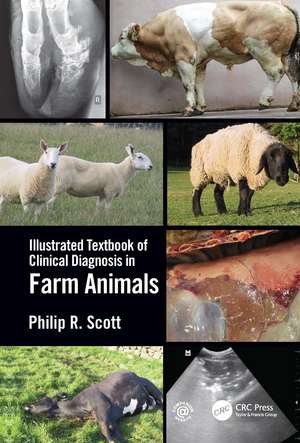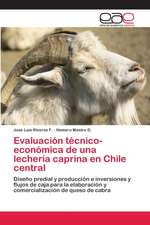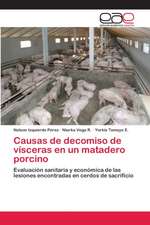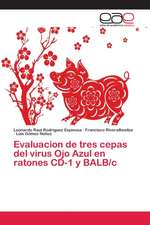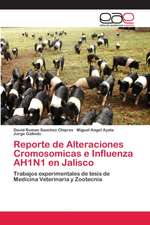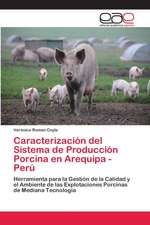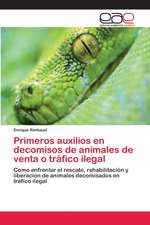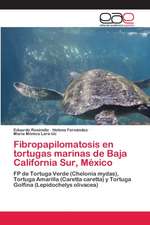Illustrated Textbook of Clinical Diagnosis in Farm Animals
Autor Philip R Scotten Limba Engleză Paperback – 15 aug 2022
-- Neil Frame, Cert.E.P, Cert.V.A, RCVS Advanced Practitioner (Equine Practice), MRCVS (vet)
Providing veterinary students with a brand-new approach to large animal medicine, this portable textbook first describes the detailed examination of each organ system achievable on the farm using technologies such as rapid ultrasound examination and radiography, illustrated via unique images and video recordings. Key points, images and video recordings then provide the ranked lists of differential diagnoses for common farm animal clinical presentations requested by veterinary students to aid their examination. The repository of over 1000 30-60 second video clips accompanying the book show the clinical presentation, diagnosis, recovery or pathology of all common disorders, accessible on the farm with a smart phone. This repository can be accessed via https://routledgetextbooks.com/textbooks/9780367612702/
Packed with imagery, the text distils the essential information in a logical, easily accessible way, aiding diagnosis. Small and spiral-bound, the book offers a lifeline for veterinary students during their EMS (extra-mural studies) placements.
Preț: 424.71 lei
Preț vechi: 461.64 lei
-8% Nou
Puncte Express: 637
Preț estimativ în valută:
81.26€ • 85.30$ • 67.45£
81.26€ • 85.30$ • 67.45£
Carte disponibilă
Livrare economică 20 martie-03 aprilie
Livrare express 05-11 martie pentru 54.42 lei
Preluare comenzi: 021 569.72.76
Specificații
ISBN-13: 9780367612702
ISBN-10: 0367612704
Pagini: 414
Ilustrații: 131 Tables, color; 2174 Halftones, color; 2174 Illustrations, color
Dimensiuni: 178 x 254 x 27 mm
Greutate: 1.12 kg
Ediția:1
Editura: CRC Press
Colecția CRC Press
ISBN-10: 0367612704
Pagini: 414
Ilustrații: 131 Tables, color; 2174 Halftones, color; 2174 Illustrations, color
Dimensiuni: 178 x 254 x 27 mm
Greutate: 1.12 kg
Ediția:1
Editura: CRC Press
Colecția CRC Press
Public țintă
Postgraduate, Undergraduate Advanced, and Undergraduate CoreCuprins
Introduction
PART 1 Veterinary Involvement on Farms
Chapter 1.1 Flock Inspection
Chapter 1.2 General examination: Toxaemia
Chapter 1.3 Pain and Fear
Chapter 1.4 Promoting veterinary services by demonstrating a benefit:cost
Chapter 1.5 Identification of acute disease in cattle
Chapter 1.6 Identification of chronic illness in cattle
PART 2 Examination of Organ Systems
Chapter 2.1 Examination of the Reproductive System
Chapter 2.2 Examination of the Digestive System
Chapter 2.3 Examination of the Respiratory System
Chapter 2.4 Examination of the Cardiovascular System
Chapter 2.5 Examination of the Nervous System
Chapter 2.6 Examination of the Musculoskeletal System
Chapter 2.7 Examination of the Urinary System
Chapter 2.8 Examination of the Skin/Fleece
Chapter 2.9 Examination of the Udder
PART 3 Clinical Problems
Chapter 3.1 Blindness
Chapter 3.2 Behavioural changes
Chapter 3.3 Weakness - spinal lesions
Chapter 3.4 Common causes of diarrhoea
Chapter 3.5 Common causes of poor appetite and low body condition
Chapter 3.6 Common causes of increased abdominal content
Chapter 3.7 Common causes of abortion in sheep
Chapter 3.8 Common causes of dystocia
Chapter 3.9 Common causes of tenesmus and prolapse
Chapter 3.10 Lameness
Chapter 3.11 Skeletal system/fractures
Chapter 3.12 Common causes of muscle lesions
Chapter 3.13 Common causes of peripheral oedema, jugular distension and ascites
Chapter 3.14 Veterinary investigation of perinatal mortality
Chapter 3.15 Poor growth rate
Chapter 3.16 Poor conception/pregnancy rate in sheep
Chapter 3.17 Common causes of tachypnoea and/or coughing
Chapter 3.18 Common causes of changes in scrotal size
Chapter 3.19 Common causes of skin lesions
Chapter 3.20 Common causes of facial/mandibular swellings in cattle
Chapter 3.21 Common causes of subcutaneous swellings in cattle
Chapter 3.22 Common causes of sudden death
Chapter 3.23 Udder lesions in cattle
Chapter 3.24 Common causes of mastitis in sheep
Chapter 3.25 Common causes of abnormal urination in sheep
Chapter 3.26 Common conditions of the penis in rams
Chapter 3.27 Common causes of weakness/recumbency
Chapter 3.28 Common causes of chronic weight loss/emaciation
PART 1 Veterinary Involvement on Farms
Chapter 1.1 Flock Inspection
Chapter 1.2 General examination: Toxaemia
Chapter 1.3 Pain and Fear
Chapter 1.4 Promoting veterinary services by demonstrating a benefit:cost
Chapter 1.5 Identification of acute disease in cattle
Chapter 1.6 Identification of chronic illness in cattle
PART 2 Examination of Organ Systems
Chapter 2.1 Examination of the Reproductive System
Chapter 2.2 Examination of the Digestive System
Chapter 2.3 Examination of the Respiratory System
Chapter 2.4 Examination of the Cardiovascular System
Chapter 2.5 Examination of the Nervous System
Chapter 2.6 Examination of the Musculoskeletal System
Chapter 2.7 Examination of the Urinary System
Chapter 2.8 Examination of the Skin/Fleece
Chapter 2.9 Examination of the Udder
PART 3 Clinical Problems
Chapter 3.1 Blindness
Chapter 3.2 Behavioural changes
Chapter 3.3 Weakness - spinal lesions
Chapter 3.4 Common causes of diarrhoea
Chapter 3.5 Common causes of poor appetite and low body condition
Chapter 3.6 Common causes of increased abdominal content
Chapter 3.7 Common causes of abortion in sheep
Chapter 3.8 Common causes of dystocia
Chapter 3.9 Common causes of tenesmus and prolapse
Chapter 3.10 Lameness
Chapter 3.11 Skeletal system/fractures
Chapter 3.12 Common causes of muscle lesions
Chapter 3.13 Common causes of peripheral oedema, jugular distension and ascites
Chapter 3.14 Veterinary investigation of perinatal mortality
Chapter 3.15 Poor growth rate
Chapter 3.16 Poor conception/pregnancy rate in sheep
Chapter 3.17 Common causes of tachypnoea and/or coughing
Chapter 3.18 Common causes of changes in scrotal size
Chapter 3.19 Common causes of skin lesions
Chapter 3.20 Common causes of facial/mandibular swellings in cattle
Chapter 3.21 Common causes of subcutaneous swellings in cattle
Chapter 3.22 Common causes of sudden death
Chapter 3.23 Udder lesions in cattle
Chapter 3.24 Common causes of mastitis in sheep
Chapter 3.25 Common causes of abnormal urination in sheep
Chapter 3.26 Common conditions of the penis in rams
Chapter 3.27 Common causes of weakness/recumbency
Chapter 3.28 Common causes of chronic weight loss/emaciation
Notă biografică
Dr. Phil Scott has 43 years’ experience of farm animal medicine and surgery in both first opinion practice and in a veterinary school teaching hospital. He has Masters and Doctoral degrees, is a Fellow of the Royal College of Veterinary Surgeons, as well as a Diplomat of the European College of Small Ruminant Health Management and the European College of Bovine Health Management. He is the author of three other textbooks, many book chapters, and over 150 referred scientific publications.
Recenzii
This book is what the veterinary student dreams of having, and yet no one has produced it - before now!
-- Chelsie Bailey, BSc Veterinary student, University of Bristol, and BSc Animal Behaviour & Welfare Science
This book represents a detailed and innovative way to learn important livestock diseases. The ultrasound sections will be extremely beneficial to students, especially the inclusion of information regarding how to use the scanner appropriately, as well as details of normal ultrasonographic findings. Having the photographs of the ultrasound scans alongside the gross pathology also helps to make connections between the two and allows for better understanding. The videos highlighting clinical presentation and diagnostics will really help students cement their understanding of the diseases and will be useful as an aid on clinical placements and thereafter.
-- Kayleigh Hanlon, Final Year Veterinary Student, University of Surrey, and BSc (Hons) Bioveterinary Science
This is a vital contribution to clinical understanding of veterinary work with ruminants, as well as reminding all of us of the part we can play every single day in terms of improving welfare. Even this week it has altered how an old set-in-my-ways practitioner thinks about things. The book is a readily available 'how to' on-the-spot guide: a new way of increasing understanding of how to actually function in veterinary practice for younger graduates, who are often cast into their first job with little experience. The wealth of videos and photos are the result of the recording of an enormous spectrum of conditions over a lifetime of work, and will be a life-saver for many.
-- Neil Frame, Cert.E.P, Cert.V.A, RCVS Advanced Practitioner (Equine Practice), MRCVS (vet)
This book is what the veterinary student dreams of having, and yet no one has produced it - before now!
-- Chelsie Bailey, BSc Veterinary student, University of Bristol, and BSc Animal Behaviour & Welfare Science
This book represents a detailed and innovative way to learn important livestock diseases. The ultrasound sections will be extremely beneficial to students, especially the inclusion of information regarding how to use the scanner appropriately, as well as details of normal ultrasonographic findings. Having the photographs of the ultrasound scans alongside the gross pathology also helps to make connections between the two and allows for better understanding. The videos highlighting clinical presentation and diagnostics will really help students cement their understanding of the diseases and will be useful as an aid on clinical placements and thereafter.
-- Kayleigh Hanlon, Final Year Veterinary Student, University of Surrey, and BSc (Hons) Bioveterinary Science
This is a vital contribution to clinical understanding of veterinary work with ruminants, as well as reminding all of us of the part we can play every single day in terms of improving welfare. Even this week it has altered how an old set-in-my-ways practitioner thinks about things. The book is a readily available 'how to' on-the-spot guide: a new way of increasing understanding of how to actually function in veterinary practice for younger graduates, who are often cast into their first job with little experience. The wealth of videos and photos are the result of the recording of an enormous spectrum of conditions over a lifetime of work, and will be a life-saver for many. I really don't think it will ever be surpassed as the 'go-to' clinical ruminant reference for undergraduates, recent grads. and vets in mixed practice who do not spend the majority of their time with farm animals. It makes me wonder what I have been doing with my veterinary life!
-- Neil Frame, Cert.E.P, Cert.V.A, RCVS Advanced Practitioner (Equine Practice), MRCVS (vet)
The book covers a wide range of topics from livestock husbandry and general examination to specific organ systems-based diseases. Each chapter presents useful descriptions of the disease and images taken ante- and post-mortem. In addition, there are 30-60-second videos of pertinent clinical cases. Tables are used throughout to help rank presenting signs and list ancillary tests. The book is written primarily with diseases present in the U.K. The discussion of animal welfare is given emphasis in diagnosis and decision-making.
-- Tessa Marshall, BVSc, MS, DABVP, University of Illinois College of Veterinary Medicine
-- Chelsie Bailey, BSc Veterinary student, University of Bristol, and BSc Animal Behaviour & Welfare Science
This book represents a detailed and innovative way to learn important livestock diseases. The ultrasound sections will be extremely beneficial to students, especially the inclusion of information regarding how to use the scanner appropriately, as well as details of normal ultrasonographic findings. Having the photographs of the ultrasound scans alongside the gross pathology also helps to make connections between the two and allows for better understanding. The videos highlighting clinical presentation and diagnostics will really help students cement their understanding of the diseases and will be useful as an aid on clinical placements and thereafter.
-- Kayleigh Hanlon, Final Year Veterinary Student, University of Surrey, and BSc (Hons) Bioveterinary Science
This is a vital contribution to clinical understanding of veterinary work with ruminants, as well as reminding all of us of the part we can play every single day in terms of improving welfare. Even this week it has altered how an old set-in-my-ways practitioner thinks about things. The book is a readily available 'how to' on-the-spot guide: a new way of increasing understanding of how to actually function in veterinary practice for younger graduates, who are often cast into their first job with little experience. The wealth of videos and photos are the result of the recording of an enormous spectrum of conditions over a lifetime of work, and will be a life-saver for many.
-- Neil Frame, Cert.E.P, Cert.V.A, RCVS Advanced Practitioner (Equine Practice), MRCVS (vet)
This book is what the veterinary student dreams of having, and yet no one has produced it - before now!
-- Chelsie Bailey, BSc Veterinary student, University of Bristol, and BSc Animal Behaviour & Welfare Science
This book represents a detailed and innovative way to learn important livestock diseases. The ultrasound sections will be extremely beneficial to students, especially the inclusion of information regarding how to use the scanner appropriately, as well as details of normal ultrasonographic findings. Having the photographs of the ultrasound scans alongside the gross pathology also helps to make connections between the two and allows for better understanding. The videos highlighting clinical presentation and diagnostics will really help students cement their understanding of the diseases and will be useful as an aid on clinical placements and thereafter.
-- Kayleigh Hanlon, Final Year Veterinary Student, University of Surrey, and BSc (Hons) Bioveterinary Science
This is a vital contribution to clinical understanding of veterinary work with ruminants, as well as reminding all of us of the part we can play every single day in terms of improving welfare. Even this week it has altered how an old set-in-my-ways practitioner thinks about things. The book is a readily available 'how to' on-the-spot guide: a new way of increasing understanding of how to actually function in veterinary practice for younger graduates, who are often cast into their first job with little experience. The wealth of videos and photos are the result of the recording of an enormous spectrum of conditions over a lifetime of work, and will be a life-saver for many. I really don't think it will ever be surpassed as the 'go-to' clinical ruminant reference for undergraduates, recent grads. and vets in mixed practice who do not spend the majority of their time with farm animals. It makes me wonder what I have been doing with my veterinary life!
-- Neil Frame, Cert.E.P, Cert.V.A, RCVS Advanced Practitioner (Equine Practice), MRCVS (vet)
The book covers a wide range of topics from livestock husbandry and general examination to specific organ systems-based diseases. Each chapter presents useful descriptions of the disease and images taken ante- and post-mortem. In addition, there are 30-60-second videos of pertinent clinical cases. Tables are used throughout to help rank presenting signs and list ancillary tests. The book is written primarily with diseases present in the U.K. The discussion of animal welfare is given emphasis in diagnosis and decision-making.
-- Tessa Marshall, BVSc, MS, DABVP, University of Illinois College of Veterinary Medicine
Descriere
Providing veterinary students with a brand-new approach to large animal medicine, this portable textbook distils the essential information in a logical, easily accessible way, aiding diagnosis. Packed with 1000+ videos and 2000+ images, the book offers a lifeline for veterinary students during EMS placements.
